A relatively uninteresting post for most but I’ve corresponded with a few people about how to fill a sanke keg and I figured it was about time I took some pics and posted a how-to for those who are interested.
The basic process is really no different from a transfer to secondary, for example. The only difference is in the connection to the keg where you need the modified coupling head. I have a spare sanke coupling head from which I have removed all the check valves:
Once the keg is cleaned and sanitized I set up just like a regular transfer. One important note is that the beer in the carboy is already cold. It’s been chilled overnight at least and sometimes longer. I have found that with all the transfers I have done that it works best for the beer to go in cold and it also carbonates faster that way.
Note that the coupling head is in place (although it should already be engaged/open), there is a bucket or something for the sanitizer to start the siphon to go into, and the sample glass at the ready.
At this point I prepare the siphon line and racking tube by filling with sanitizer and double kinking the end. Note that the end of the siphon line has the tail piece and beer nut attached. I have two separate lines for transfers, one with a tail piece and one without. Just makes my set up easier.
We now have everything in place to start the transfer and filling the keg.
I start the siphon by putting the racking cane in the carboy and letting the sanitizer flow into the bucket. Once the beer only is flowing through I take a small sample into the glass then re-kink the line and immediately connect the line to the coupling head. Note (once again): the coupling head should be engaged and open on the top of the keg.(I think my directions weren’t clear when I was taking the photos but I do always do this with the coupling head engaged. Bizarre…)
Once the line is threaded onto the coupling head I un-kink the line to let the beer flow into the sanke. I usually give a quick tighten just to ensure that it doesn’t leak.
It may be obvious by now but this is what my final set up looks like as the keg is filling.
Once the keg is full you’re ready to carbonate and serve or bottle depending on how your system is set up. For me, my keg goes straight to the fridge for carbonating and tapping. I bottle very little and only a bit at a time as the need arises.
My carbonating set up is pretty straight forward. I use one of my dispense coupling heads but with the lines reversed so that the CO2 is going in through the spear of the keg. I also have the ball check valve removed and I cap the other line using a dime between the gasket and the tailpiece.
To be honest, I’m not sure if this is totally necessary as I do have the check valve in place on the gas-in port but I like the little bit of assurance that this simple addition provides.
This is what everything looks like when I’m ready to carb:
Before engaging the coupling head I set my regulator to about 20psi. That’s what hits the beer initially and then I purge the keg just to remove any remaining oxygen. Once the keg is pressurized I let it sit for a half hour or so and then shake it.
Let it settle for another hour or so still at 20psi. I then shut off the gas, purge the keg, reset the regulator to serving pressure (11psi for me) and turn the gas back on. I still have the lines reversed and the gas is still going in through the spear. Over the next several hours I shake the keg frequently in order to maximize the distribution of the CO2 and after about 6 hours or so I have carbonated beer ready to drink.
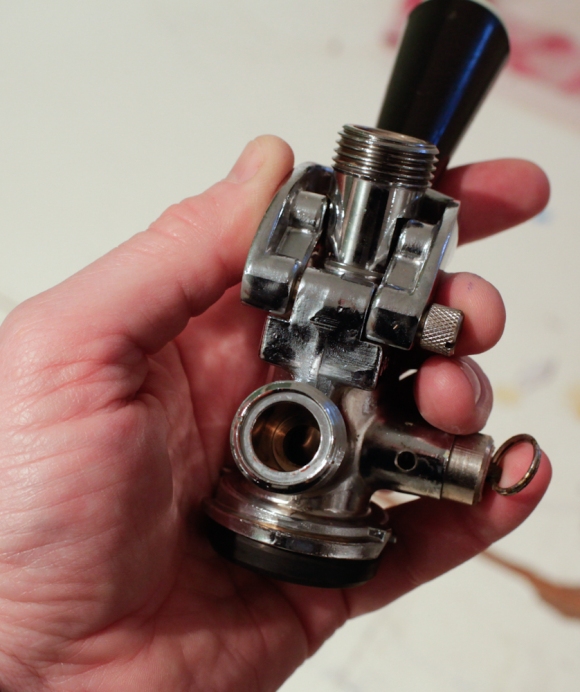

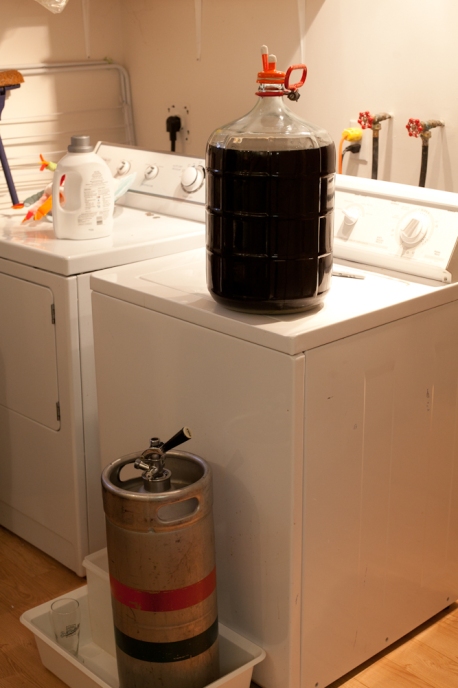
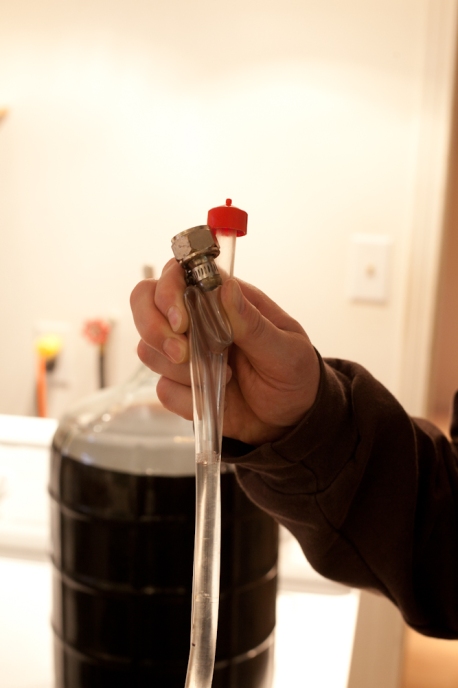
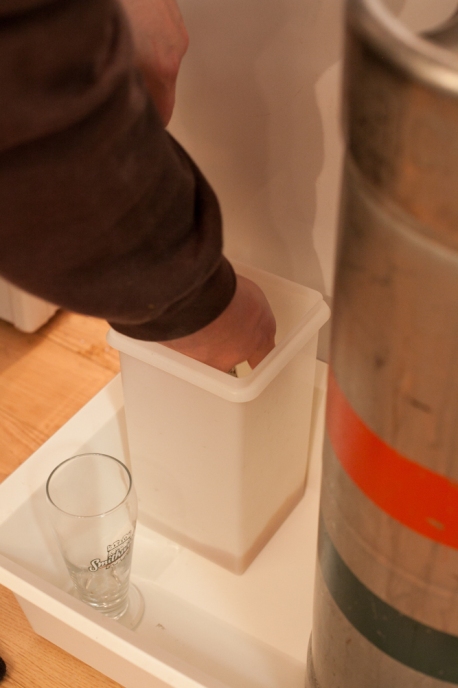
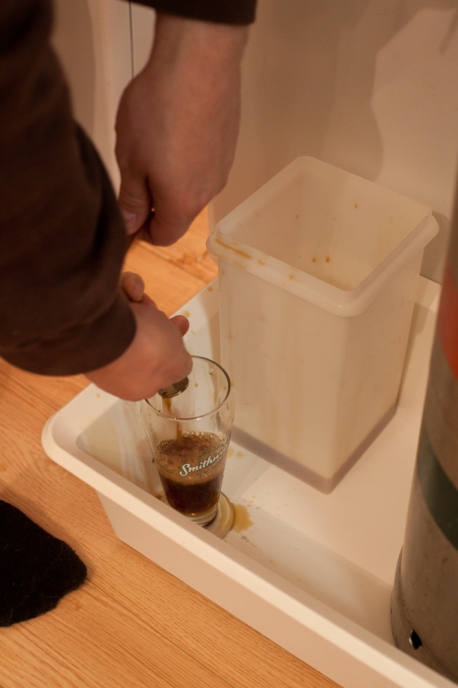
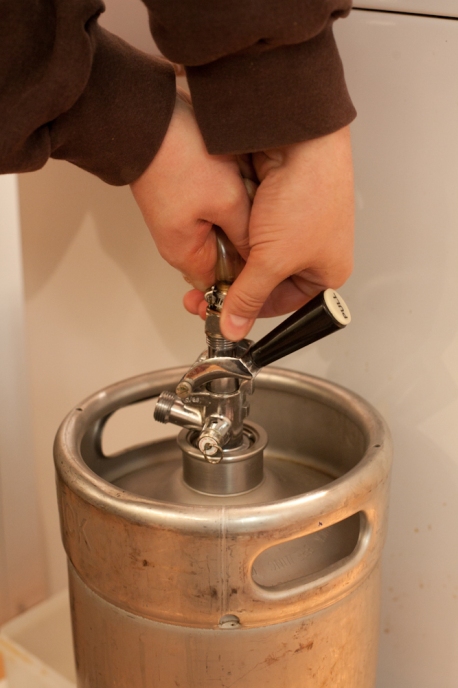
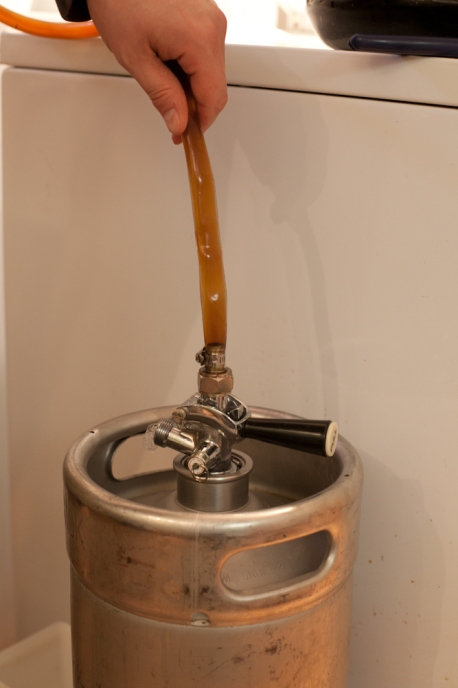
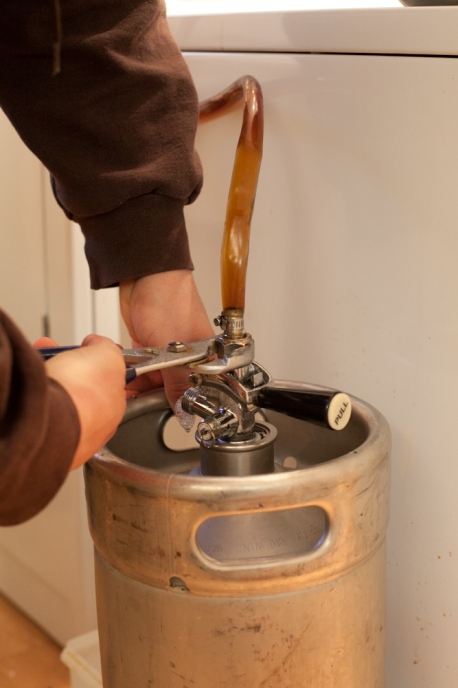
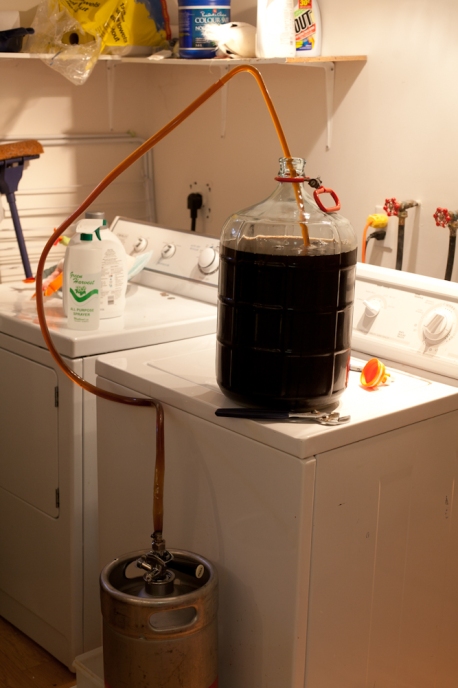
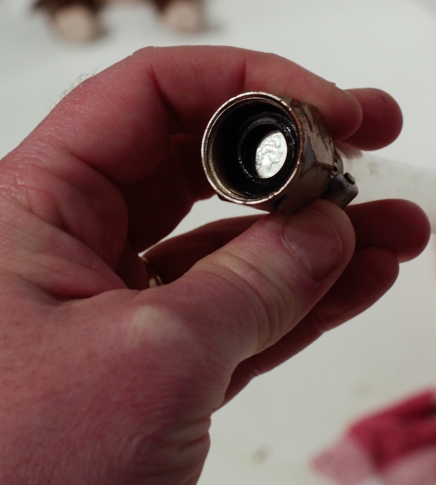
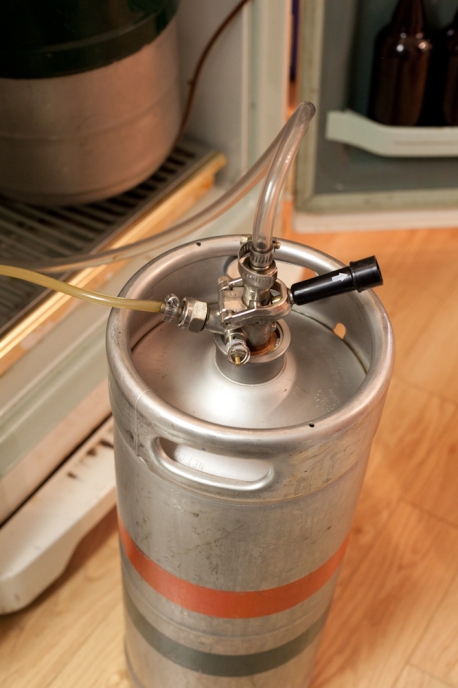
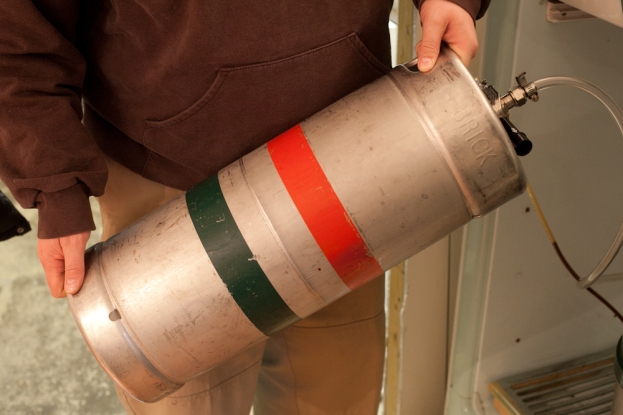
May 21st, 2012 at 3:50 pm
Reblogged this on Beerincubator and commented:
Useful tutorial
June 6th, 2012 at 4:35 pm
Really nice!
June 19th, 2012 at 9:30 pm
I’d really be interested in the sanke coupler build outs 🙂 are you blogging on those?
June 21st, 2012 at 5:11 pm
I’m not sure what you mean by the build outs. Can you clarify?
June 21st, 2012 at 3:43 pm
I don’t understand why you would reverse the lines for carbonating. It should carbonate just fine the normal way. Am I missing something?
June 21st, 2012 at 5:10 pm
It would seem, in theory, that it should carbonate the same the other way but in my experience it just doesn’t. I can carb much faster by reversing the lines, so far in as little as 6 hours.
Set and forget works just as well for getting gas into solution in the beer but then you’re looking at more than a week vs much less than a day. In my set up I prefer faster. That’s just me, though. 😀
June 22nd, 2012 at 2:10 pm
Understood. I usually hook it up normally, set the psi to 30 for 36 hrs, then purge and bring it down to serving pressure. Usually takes about 2 – 2.5 days for it to be finished.
June 22nd, 2012 at 2:32 pm
So I just did a test run, filling a sanke with a half gallon or so of water. Your method works. Have you had issues with oxygenation? I feel like I can hear the water splashing around in there as it fills. Maybe this is because I didn’t fill it that full, or maybe it’s not really splashing, just filling quickly. And I guess the real question is, does the spear fill the keg from the bottom up?
June 22nd, 2012 at 2:46 pm
Revised: Ok, I just ripped the keg apart and realized where the sound was coming from. It does fill from the bottom up, but the diameter of the spear is 1″, while the diameter of the siphon hose is 5/16″. So the beer is flowing from a small tube into a larger one, which I think makes it fall down instead of flow down. I would think this would oxidize the beer a bit, but I could be wrong. Maybe one way around this would be putting a reducer on the bottom of the spear to make it match the diameter of the hose, so there would be enough back flow to relieve the turbulence. I’m just throwing out ideas. Thoughts?
November 4th, 2012 at 5:07 pm
I was thinking about the oxidation issue as well. I haven’t used any of my sanke kegs yet, just removed the spears to give them a good cleaning. Honestly my palate probably won’t pick up the oxidation if it is minimal… Anyone had an issue with this procedure creating noticeable oxidation?
November 6th, 2012 at 7:18 am
There may well be oxidation but it is minimal and if it’s more than that it doesn’t bother me. LOL
I haven’t had any negative comments to that effect on my beer but that certainly doesn’t mean it’s not happening or is not present.
There are always better/more efficient/cheaper/more expensive ways of doing something. This is a way that works for me with what I have and definitely gets the job done: Beer gets into the keg!
November 7th, 2012 at 9:53 am
You hit it on the head there. I know the way I do things is different then other homebrewers, but it is good to throw ideas like this around to come up with new innovative ways to do the same thing, like 5point mentioned a reducer…look for it on the market next month 🙂
December 28th, 2012 at 1:54 pm
How do you sanitize the keg prior to filling it?
December 28th, 2012 at 2:31 pm
I just put a funnel in the top of the coupling head and dump in some Starsan. Move it and shake it like I would with a carboy and it’s sanitized.
January 7th, 2013 at 9:40 am
[…] my blog for it. If you have more questions please feel free to PM me, I'm always happy to help. https://itswhatsontap.wordpress.com/2012/05/21/filling-a-sanke-keg-tutorial/ […]
March 11th, 2013 at 9:25 pm
So… I’m slightly confused. If you sanitize your keg with the spear removed (or did I read that wrong?), why wouldn’t you just fill it with the spear removed and then replace it and carbonate? Pretty much like racking into another carboy. I’m new to this stuff so just wondering.
March 21st, 2013 at 2:16 pm
[…] a link to another way. I just wonder about oxygenation and cleaning. https://itswhatsontap.wordpress.com/2012/05/21/filling-a-sanke-keg-tutorial/ […]
March 22nd, 2013 at 11:33 am
Hey, great thread & very helpful as I’ve recently been working to get my kegging set up with sanke kegs. I seem to have several of the same questions.
Is it necessary to take the spear out to clean/sanitize/fill etcetera? Despite the thrill of taking apart your first keg spear, it is a pain that if avoidable would be useful.
Does the diameter of the spear tube v. the fill tube result in oxygen pick up?
Could this be address by simply tilting the keg during filling so the beer runs down the inside of the spear rather than just fall down?
What are the experiences with using these kegs for secondary & serving, does the extra yeast/trub mean the keg should be taken apart for cleaning rather than the shake n’ bake method?
March 22nd, 2013 at 2:27 pm
It is definitely better to take the spear out and clean/sanitize/fill. I’m lazy, so I don’t do it every time. LOL I find it a real pain to replace the spear once I’ve pulled it so I tend to do everything through the coupling head. Purge, rinse, strong cleaner, drain, rinse, sanitize, fill.
Yes, I’m sure there oxygen pick up in the filling of the keg. A significant amount? I don’t know. Noticeable? Perhaps, but not to me. I like the idea of tipping the keg to reduce that. I will definitely be trying that on my next fill. Thanks for that suggestion.
I wouldn’t use it for secondary only because of the amount of trub then going through your beverage lines unless you have another way of clearing it. I secondary and cold crash/gel before filling the keg. That’s just my preference and it seems to work well. I don’t always serve crystal clear beer but it gets me to a place that is reasonable for serving.
March 25th, 2013 at 11:02 am
I follow a similar process except I purge the receiving keg with CO2 before the transfer. This way the transfered beer drops into CO2 and below any O2 that might be in the keg. Since Co2 is heavier than O2, there is separation that occurs after waiting 3-5 minutes. A little starsan also helps gauge the fill progress.
May 22nd, 2013 at 9:58 am
Hey, I am curious about your siphoning setup. I will be doing something similar. I have a keg which I turned into a fermenter. I am going to transfer from the one keg to another but by using a siphon. Could you explain more in detail on how to get the siphon working? I would figure you would need to suck/blow to get the transfer started but doesn’t sound like you do… Any help would be great.
May 23rd, 2013 at 6:00 am
Are you fermenting under pressure in the keg/fermenter? If so, you may have to set up a transfer via a jumper. That is, transferring under pressure as well using co2 to move the beer out of one fermenter into another.
If you’ve pulled the spear from the fermenter to use it similar to fermenting in a carboy then you can use a siphon to transfer. That method would be similar to what I show in my post: fill the line with starsan, kink the end of the line, connect to the coupling head, release the kink. You should then be siphoning.
Let me know more about what you’re doing and I may be able to help with the set up.
Thanks for stopping by!
October 5th, 2013 at 7:24 pm
My question is : how do you fill from your fermenter without filtering the beer?
October 6th, 2013 at 8:56 am
Ummmm… I don’t filter. I usually either add gelatin to the beer and cold crash or just cold crash. I have filtered in the past but have a look at this post to see why I don’t anymore.
October 6th, 2013 at 10:34 am
Thanks for the quick reply. I used this kegging method last night and it worked great. I sanitized the keg and filled it with co2 to minimize oxidization. I monitored the siphon so I didn’t get too much sediment. This was so much easier than using a corny keg.
November 3rd, 2014 at 9:58 pm
If u have the co2 going in thru the spear, how does the beer come out?
November 30th, 2014 at 11:21 pm
At filling, I’m not using any CO2.
October 10th, 2015 at 6:35 am
Very informative post! I just had one question. I recently bought a new Sanke keg and coupler. I am able to remove the check valve at the gas inlet. But I can’t remove the check valve at the beer outlet. I can see a certain ‘Mercedez Benz’ kinda logo at the beer outlet. That’s the check valve, right? How do I remove that? Just pull it out?
October 10th, 2015 at 3:38 pm
Yeah, that Benz logo thing is part of the check valve. There are two in there that retain a ball that is the actual check valve. Try some needle nose pliers or similar to pull the Benz logo out and the ball should just fall out. Once that is out you’re good to go.
October 23rd, 2015 at 12:11 pm
And it came off quite easily! Awesome! I actually had one more question. So I saw that you place a dime between the gasket and the tailpiece to hold in the pressure which is a brilliant idea! You also carbonate your beer through the spear. I’m thinking of carbonating through the gas in port. And I’ve got one beer shutoff valve so can I just turn it off to carbonate the beer? The valve should hold that much pressure right?
October 23rd, 2015 at 9:28 pm
You should be fine. It will take a bit longer to carb but shouldn’t be a problem.